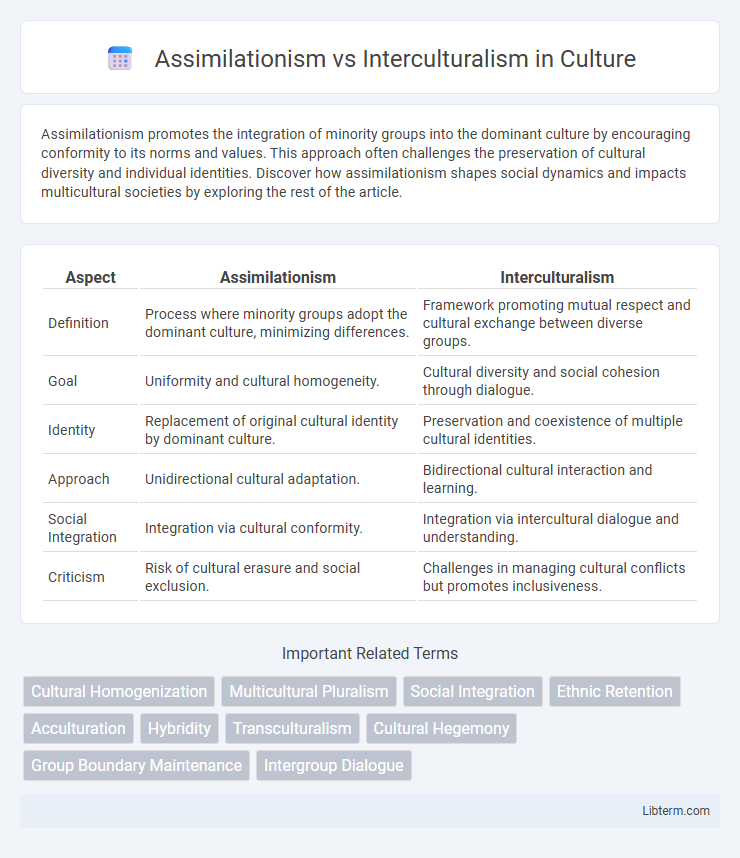Assimilationism promotes the integration of minority groups into the dominant culture by encouraging conformity to its norms and values. This approach often challenges the preservation of cultural diversity and individual identities. Discover how assimilationism shapes social dynamics and impacts multicultural societies by exploring the rest of the article.
Table of Comparison
| Aspect | Assimilationism | Interculturalism |
|---|---|---|
| Definition | Process where minority groups adopt the dominant culture, minimizing differences. | Framework promoting mutual respect and cultural exchange between diverse groups. |
| Goal | Uniformity and cultural homogeneity. | Cultural diversity and social cohesion through dialogue. |
| Identity | Replacement of original cultural identity by dominant culture. | Preservation and coexistence of multiple cultural identities. |
| Approach | Unidirectional cultural adaptation. | Bidirectional cultural interaction and learning. |
| Social Integration | Integration via cultural conformity. | Integration via intercultural dialogue and understanding. |
| Criticism | Risk of cultural erasure and social exclusion. | Challenges in managing cultural conflicts but promotes inclusiveness. |
Understanding Assimilationism: Definition and Core Principles
Assimilationism emphasizes the absorption of minority cultures into the dominant society, promoting uniformity in language, values, and behaviors to achieve social cohesion. Core principles include the expectation that immigrants or minority groups adopt the host culture's norms and customs, often at the expense of their original cultural identity. This approach contrasts with multicultural models by prioritizing social integration through cultural conformity rather than cultural diversity or exchange.
Exploring Interculturalism: A Modern Approach to Diversity
Interculturalism emphasizes active dialogue and mutual respect among diverse cultural groups, promoting social cohesion without erasing distinct identities. Unlike assimilationism, which advocates for minority groups to conform to the dominant culture, interculturalism encourages the recognition and celebration of cultural differences. This modern approach fosters inclusive policies that support integration while valuing multicultural exchanges and shared cultural development.
Historical Context: Roots of Assimilationism and Interculturalism
Assimilationism emerged prominently in the 19th and early 20th centuries as nation-states sought to create homogenous identities by encouraging immigrants and minority groups to adopt the dominant culture's language, customs, and values. Interculturalism developed later, particularly in multicultural societies like Canada and Quebec during the late 20th century, as a response to the limitations of assimilation, promoting mutual respect and dialogue between diverse cultural groups. The historical roots of assimilationism lie in colonial and nationalist policies aimed at social cohesion through cultural uniformity, while interculturalism is rooted in postcolonial and pluralistic frameworks that recognize and celebrate cultural diversity within a shared public space.
Policy Differences: Assimilationist vs Intercultural Initiatives
Assimilationist policies emphasize uniformity by encouraging minority groups to adopt the dominant culture's language, values, and customs, often leading to the erosion of cultural identities. In contrast, intercultural initiatives promote mutual respect and dialogue between diverse groups, supporting cultural maintenance while fostering shared social cohesion. These policy differences reflect fundamentally distinct approaches to managing diversity within multicultural societies.
Social Integration: Navigating Identity and Belonging
Assimilationism emphasizes conformity to the dominant culture as a pathway to social integration, often requiring individuals to suppress distinct cultural identities to achieve belonging. Interculturalism promotes mutual respect and dialogue, encouraging the coexistence of diverse identities within a shared social framework. This approach supports dynamic identity negotiation, fostering inclusion while valuing cultural differences in the fabric of society.
Cultural Preservation vs Cultural Blending
Assimilationism emphasizes cultural preservation by encouraging minority groups to adopt the dominant culture's customs, language, and values, often leading to the erosion of original cultural identities. Interculturalism promotes cultural blending through mutual respect, dialogue, and exchange, allowing diverse cultures to coexist and enrich each other within a pluralistic society. This dynamic interaction fosters a shared social fabric while maintaining distinct cultural expressions.
The Role of Education in Shaping Diversity Models
Education influences diversity models by promoting either Assimilationism, which encourages minority groups to adopt the dominant culture's norms, or Interculturalism, which fosters mutual respect and interaction among distinct cultures. Schools that emphasize Assimilationism often prioritize standardized curricula aimed at cultural uniformity, while Interculturalism-based education integrates multicultural perspectives, supporting bilingual programs and cultural exchange. Research indicates that intercultural education enhances social cohesion and cultural competence, making it a pivotal tool in shaping inclusive societies.
Criticisms of Assimilationism: Loss of Heritage and Identity
Assimilationism faces criticism for promoting the loss of cultural heritage and identity by encouraging minority groups to abandon their customs and languages in favor of the dominant culture's norms. This approach can lead to social alienation and the erasure of diverse traditions, diminishing multicultural richness. Scholars argue that assimilation undermines individual and collective cultural expression, fostering homogenization rather than genuine inclusion.
Advantages and Challenges of Interculturalism
Interculturalism promotes social cohesion by encouraging mutual respect and dialogue among diverse cultural groups, fostering inclusive societies where cultural differences are recognized and valued. It addresses challenges such as potential cultural fragmentation and the difficulty of balancing distinct cultural identities within a shared public space. The approach enhances social integration by promoting active participation and equal rights without erasing cultural uniqueness, contrasting with the assimilationist focus on cultural uniformity.
Future Perspectives: Towards Inclusive Multicultural Societies
Future perspectives on assimilationism and interculturalism emphasize the transition towards inclusive multicultural societies that prioritize mutual respect and cultural exchange over forced conformity. Interculturalism promotes dynamic interaction, fostering social cohesion and equity by valuing diverse cultural identities within a shared public space. This approach supports policy frameworks encouraging integration without erasure, enhancing societal resilience and innovation in increasingly diverse populations.
Assimilationism Infographic

 libterm.com
libterm.com